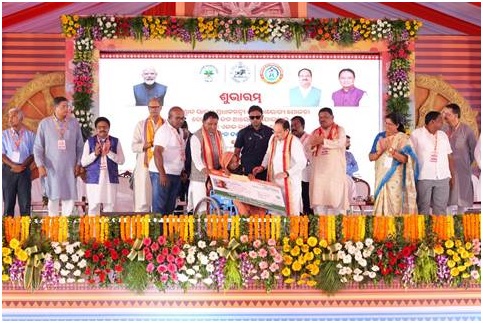Ayushman Bharat scheme is benefiting people across the nation, especially the poor and underprivileged section
Union Health Minister ShriJagatPrakashNadda and Shri Mohan CharanMajhi, Chief Minister, Odisha, distributed cobranded cards of Ayushman Bharat PradhanMantri – Jan ArogyaYojana and Gopabandhu Jan ArogyaYojana, in Cuttack today. The AyushmanVayaVandanaYojana was also launched during the event. ShriJualOram, Union Minister of Tribal Affairs; ShriMukeshMahaling, Minister, Health and Family Welfare, Odisha and Members of Parliament and Legislative Assembly of Odisha were also present on the occasion.

Addressing the gathering, Shri JP Nadda said that “today is a historic day for Odisha as the AB PM-JAY, the world’s largest health coverage program under which 62 crore people are currently being benefitted, will connect approximately 1.3 crore families, almost 3.52 crore people of Odisha.”
ShriNadda informed that more than 8.19 crore people have availed services under the scheme and Rs 1.26 lakh crore have been spent under the same to provide healthcare services to the people of the country.
The Union Health Minister highlighted that around 61 crore people are covered under the scheme now. He said, “earlier, more than 55 crore people were covered under the scheme. Then ASHAs, Anganwadi workers and their families i.e. approximately 36 lakh people were added in the scheme. “In October last year, people over 70 yrs of age were covered under the scheme and now, with the implementation of AyushmanVayaVandana in Odisha, all senior citizens aged 70 years and above, irrespective of their socio-economic status, will be covered”, he stated.
ShriNadda pointed out that the out-of-pocket expenditure has declined from 62% to 38% today as a result of the Ayushman Bharat scheme”. He also highlighted that under the 100-day TB Intensified Elimination Programme, Odisha proactively participated identified 16,500 new cases. “Under PM ABHIM, Rs. 1,411 crores have been provided for strengthening the healthcare infrastructure of Odisha”, he stated.
Speaking on the occasion, Shri Mohan CharanMajhi highlighted that launch event as “another feather added to Odisha's development story”. He stated that “from today onwards, beneficiaries of Odisha will get free healthcare facility. Odia people residing outside the state will also get the benefit. They can avail the facility in the hospitals outside the state.”
He stated that under the leadership of Prime Minister Modi, Ayushman Bharat scheme is benefiting people across the nation, especially the poor and underprivileged section.
ShriMajhi informed that more than 4,000 doctors have been appointed under the current administration and 5,000 more appointments are under process. He underlined the commitment of the state government to strengthen health infrastructure in the state and stated its aim to establish medical college in all the districts of the state.
ShriJualOram noted that tribals of Odisha will be greatly benefited under the scheme. He stated that “people of the state are elated with the implementation of the scheme.”
ShriMukeshMahaling highlighted that “3.50 Cr people of the state will get health insurance cards under Ayushman Bharat &Gopabandhu Jan ArogyaYojana and 23 lakhs elderly people in Odisha will also be benefited under the VayaVandanaYojana.”.
